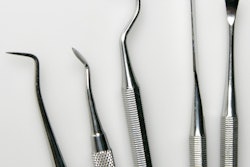
DrBicuspid.com is pleased to publish this column by Louis DePaola, DDS, on the principles of infection control for handpieces.
 Louis DePaola, DDS.
Louis DePaola, DDS.The handpiece is arguably one of the most essential devices found in a practice. However, as it routinely comes into direct contact with blood, saliva, oral mucous membranes, and the oral flora, the handpiece must be rendered noninfectious before it is used on subsequent patients. How is this accomplished?
A headpiece is a complex and expensive device. Device sterilization was initially not considered, and, until the mid-1990s, most handpieces were simply not made to withstand heat sterilization.
When sterilizable handpieces were introduced in the late 1980s, the devices were expensive, prone to malfunction, and not well received by the profession. Practice economics somewhat discouraged their use, as the sterilization process would remove a costly and often-used device from service for a period of time. This, in turn, meant practices would have to purchase additional handpieces. A practice's operational overhead also was increased, as more time was required to clean, lubricate, wrap, and process each handpiece.
Heat sterilization
In 1978, the ADA recommended that, "until handpieces can be replaced with models that can be routinely sterilized, scrubbing them in detergent solutions and wiping with alcohol is an alternative" (Journal of the American Dental Association, October 1978, Vol. 97:4, pp. 673-677).
“Handpieces that cannot be sterilized should not be used.”
At that time, the great majority of handpieces were not autoclavable, and this procedure was followed by most dentists. However, new infectious diseases were emerging, and very soon HIV/AIDS cases were reported in the U.S. The emergence of HIV and, to a lesser extent, hepatitis B and hepatitis C (then known as non-A and non-B hepatitis) raised concerns regarding a potential risk between the transmission of bloodborne disease and dental procedures, many of which involved contamination with blood. Better infection-control practices needed to be developed and implemented, and the handpiece became the focus of concern.
To address infection control in the dental office, U.S. Centers for Disease and Prevention (CDC) published in 1986 a recommendation for infection control in dentistry in Morbidity and Mortality Weekly Report (MMWR) (April 18, 1986, Vol. 35:15, pp. 237-242). This recommendation stressed fundamental infection-control practices and stated that "routine sterilization of handpieces is desirable; however, not all handpieces can be sterilized." At the time, most handpieces were not heat sterilizable.
In 1990, the dental profession was stunned when the CDC published a case report in MMWR (July 1990, Vol. 39:29, pp:489-493) about a young woman infected with HIV/AIDS without the usual risk factors. It was discovered that she had two teeth extracted by a dentist who had contracted AIDS, and the report suggested a link between the transmission of HIV from the dentist to the patient during an invasive dental procedure.
Subsequently, it was determined that this case and five additional cases of HIV transmissions were linked to one Florida dentist. Although the exact cause of the HIV transmissions has never been identified, no other cases of similar transmission have been reported, and no cases from dentistry have been reported since.
Due to the almost pathological "AIDS hysteria" prevalent at the time, this report caused significant concern for consumers and the dental profession. Patients demanded protection from exposure to disease transmission in the dental office, bringing the importance of infection control in dentistry to the forefront. While most instruments could be easily sterilized or were available in disposable form, a majority of handpieces at the time could only be disinfected on the exterior surfaces, which, at the time, was thought to be sufficient to prevent the spread of infection.
Internal surfaces
However, this philosophy changed with the publication of a 1992 study in the Journal of Clinical Microbiology (February 1992, Vol. 30:2, pp. 401-406), suggesting that the internal surfaces of the handpiece could serve as a reservoir for microbial contamination from previous patients. Furthermore, this contaminate could be expelled into the oral tissues and membranes of subsequent patients and possibly could transmit infections, including HIV, from patient to patient.
This investigation reignited the controversy surrounding infection control in the dental office and specifically targeted the handpiece. Because these handpieces are a device regulated by the U.S. Food and Drug Administration (FDA), the administration recommended in 1992 that reusable dental handpieces and related instruments be heat-sterilized between each patient use.
In May 1993, the CDC published recommendations for infection control and stated that "routine between-patient use of a heating process capable of sterilization is recommended" for dental handpieces (MMWR, May 28, 1993, Vol. 41:RR-8, pp. 1-12).
Building on the 1993 recommendations, the CDC published evidence-based guidelines in 2003 (MMWR, December 19, 2003, Vol. 52:RR17, pp. 1-61) for infection control in dentistry. These stated that, although handpieces (including high- and low-speed motors, contra/prophy angles, and ultrasonics) are considered semicritical items, they should always be heat sterilized between uses. Furthermore, neither surface disinfection nor immersion in chemical germicides is an acceptable method for handpiece sterilization.
In 2008, the CDC published the "Guideline for Disinfection and Sterilization in Healthcare Facilities, 2008," that stated that handpieces can be contaminated internally with patient material and should be sterilized after each patient. Ten years later in 2018, the CDC published the "CDC Statement on Reprocessing Dental Handpieces." This statement removes any ambiguity regarding the sterilization of dental handpieces and offers three recommendations:
- Clean and heat sterilize handpieces and other intraoral instruments that can be removed from the air lines and water lines of dental units.
- For handpieces that do not attach to air lines and water lines, use FDA-cleared devices and follow the validated manufacturer's instructions for reprocessing these devices.
- If a dental handpiece cannot be heat sterilized and does not have FDA clearance with validated instructions for reprocessing, do not use that device.
While the CDC is not a regulatory body, these recommendations are widely accepted by dental boards and are incorporated into dental practice acts in many states, thus becoming standards of care. In the 2018 statement, the CDC clearly stated that these handpieces, including high- and low-speed motors and contra/prophy angles, should be sterilized between patients.
Dental professionals should be familiar with and compliant with the CDC's statement. Handpieces that cannot be sterilized should not be used.
Dr. DePaola is the associate dean of clinical affairs and a professor in the department of oncology and diagnostic sciences at the University of Maryland School of Dentistry in Baltimore. He is also the director for dental training for the MidAtlantic AIDS Education and Training Center.
The comments and observations expressed herein do not necessarily reflect the opinions of DrBicuspid.com, nor should they be construed as an endorsement or admonishment of any particular idea, vendor, or organization.



















